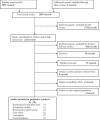A systematic review of the effects of sedatives and anesthetics in patients with obstructive sleep apnea
- PMID: 22096275
- PMCID: PMC3214547
- DOI: 10.4103/0970-9185.86574
A systematic review of the effects of sedatives and anesthetics in patients with obstructive sleep apnea
Abstract
The objective of this review is to determine the effects of perioperative sedatives and anesthetics in surgical patients with obstructive sleep apnea (OSA) on respiratory events, medication requirements, hemodynamics, pain, emergence, and hospital stay. We searched The Cochrane CENTRAL Register of Controlled Trials, Medline, Embase, and Cochrane Database of Systematic Reviews from 1950 to June 2010 for relevant articles. All prospective and retrospective studies were eligible for inclusion if the effects of perioperative administration of sedation and anesthetics on medication requirements, pain, emergence, hemodynamics, respiratory events, and length of hospital stay in OSA patients were reported. The search strategy yielded 18 studies of 1467 patients. Of these, 456 patients were documented as having OSA. Few adverse respiratory effects were reported. Eight out of 700 (1.14%) patients undergoing middle ear surgery with midazolam and fentanyl had impaired upper airway patency and were retrospectively diagnosed as having OSA by polysomnography. Also, intraoperative snoring causing uvular edema in the postoperative period was described in an OSA patient undergoing upper limb surgery when propofol was administered with midazolam and fentanyl for sedation. A decrease in oxygen saturation in the postoperative period was described with propofol and isoflurane in 21 OSA patients undergoing uvulo-palato-pharyngoplasty and tonsillectomy surgery (P<0.05). Perioperative alpha 2 agonists were shown to decrease the use of anesthetics (P<0.05), analgesics (P=0.008) and anti-hypertensives (P<0.001) in OSA patients. Contradictory reports regarding emergence occurred with intraoperative dexmedetomidine. Intraoperative opioids decreased the analgesic consumption (P=0.03) and pain scores (P<0.05) in the postoperative period. There was limited data on the length of hospital stay. There were few adverse effects reported when patients with known OSA underwent elective surgery with the currently available sedatives and anesthetics. Adverse events were reported with midazolam. However, the quality and number of patients in the studies were limited. There is a need for further trials with large numbers and uniform reporting of outcomes.
Keywords: Anesthetics; effects; obstructive sleep apnea; sedative.
Conflict of interest statement
Figures
Similar articles
-
Preoperatively Screened Obstructive Sleep Apnea Is Associated With Worse Postoperative Outcomes Than Previously Diagnosed Obstructive Sleep Apnea.Anesth Analg. 2017 Aug;125(2):593-602. doi: 10.1213/ANE.0000000000002241. Anesth Analg. 2017. PMID: 28682951
-
Postoperative hypoxemia in morbidly obese patients with and without obstructive sleep apnea undergoing laparoscopic bariatric surgery.Anesth Analg. 2008 Jul;107(1):138-43. doi: 10.1213/ane.0b013e318174df8b. Anesth Analg. 2008. PMID: 18635479
-
Anti-inflammatory medications for obstructive sleep apnoea in children.Cochrane Database Syst Rev. 2020 Jan 17;1(1):CD007074. doi: 10.1002/14651858.CD007074.pub3. Cochrane Database Syst Rev. 2020. PMID: 31978261 Free PMC article.
-
Effect of sedative-hypnotics, anesthetics and analgesics on sleep architecture in obstructive sleep apnea.Expert Rev Clin Pharmacol. 2014 Nov;7(6):787-806. doi: 10.1586/17512433.2014.966815. Expert Rev Clin Pharmacol. 2014. PMID: 25318836 Review.
-
Dexmedetomidine infusion for analgesia and prevention of emergence agitation in children with obstructive sleep apnea syndrome undergoing tonsillectomy and adenoidectomy.Anesth Analg. 2010 Oct;111(4):1004-10. doi: 10.1213/ANE.0b013e3181ee82fa. Epub 2010 Aug 12. Anesth Analg. 2010. PMID: 20705788 Clinical Trial.
Cited by
-
Doxapram hastens the recovery following total intravenous anesthesia with dexmedetomidine, propofol and remifentanil.Exp Ther Med. 2015 Apr;9(4):1518-1522. doi: 10.3892/etm.2015.2249. Epub 2015 Feb 2. Exp Ther Med. 2015. PMID: 25780462 Free PMC article.
-
High STOP-BANG questionnaire scores predict intraoperative and early postoperative adverse events.Singapore Med J. 2015 Apr;56(4):212-6. doi: 10.11622/smedj.2015034. Singapore Med J. 2015. PMID: 25917473 Free PMC article.
-
Risk of sedation for diagnostic esophagogastroduodenoscopy in obstructive sleep apnea patients.World J Gastroenterol. 2013 Aug 7;19(29):4745-51. doi: 10.3748/wjg.v19.i29.4745. World J Gastroenterol. 2013. PMID: 23922472 Free PMC article.
-
Society of Anesthesia and Sleep Medicine Guideline on Intraoperative Management of Adult Patients With Obstructive Sleep Apnea.Anesth Analg. 2018 Oct;127(4):967-987. doi: 10.1213/ANE.0000000000003434. Anesth Analg. 2018. PMID: 29944522 Free PMC article.
-
Society of Anesthesia and Sleep Medicine Guidelines on Preoperative Screening and Assessment of Adult Patients With Obstructive Sleep Apnea.Anesth Analg. 2016 Aug;123(2):452-73. doi: 10.1213/ANE.0000000000001416. Anesth Analg. 2016. PMID: 27442772 Free PMC article. Review.
References
-
- Young T, Palta M, Dempsey J, Skatrud J, Weber S, Badr S. The occurrence of sleep-disordered breathing among middle-aged adults. N Engl J Med. 1993;328:1230–5. - PubMed
-
- Young T, Peppard PE, Gottlieb DJ. Epidemiology of obstructive sleep apnea-A population health perspective. Am J Respir Crit Care Med. 2002;165:1217–39. - PubMed
-
- Bixler EO, Vgontzas AN, Ten HT, Tyson K, Kales A. Effects of age on sleep apnea in men: 1. Prevalence and severity. Am J Respir Crit Care Med. 1998;157:144–8. - PubMed
-
- Bixler EO, Vgontzas AN, Lin HM, Ten Have T, Rein J, Vela-Bueno A, et al. Prevalence of sleep-disordered breathing in women : Effects of gender. Am J Respir Crit Care Med. 2001;163:608–13. - PubMed
-
- Schwab RJ, Pasirstein M, Pierson R, Mackley A, Hachadoorian R, Arens R, et al. Identification of upper airway anatomic risk factors for obstructive sleep apnea with volumetric magnetic resonance imaging. Am J Respir Crit Care Med. 2003;168:522–30. - PubMed
LinkOut - more resources
Full Text Sources
Medical


